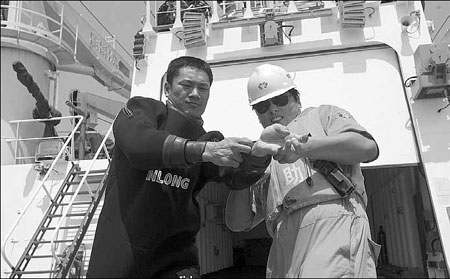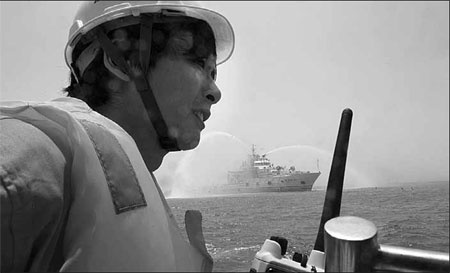Narrow escape from vessel prompts sailor to 'rethink the value of life'
Updated: 2013-08-12 07:11
By Wang Zhenghua in Zhoushan, Zhejiang (China Daily)
|
||||||||
|
Diver Tang Shunjie (left) wears diving gear on Donghai rescue vessel No 110 in July. Gao Erqiang / China Daily |
|
Rescue vessel No 110, operated by the Donghai Rescue Bureau, operates its water cannons in July. Gao Erqiang / China Daily |
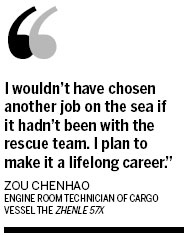
It was Dec 4, 2005, and Zou Chenhao had a life-or-death decision to make.
His thoughts turned to his family and his girlfriend. He knew waiting just a few seconds might mean never seeing them again.
Then he jumped.
Zou was on the crew of cargo vessel the Zhenle 57 when it sank during a heavy storm off China's east coast, killing five people.
Zou survived by leaping from the deck onto a rescue boat 10 meters below.
"That narrow escape made me rethink the value of life," he said. "When a sailor is saved, it's not only one life. Society benefits, too."
Since then, he has been the one doing the saving, as a member of the Ministry of Transport's Donghai Rescue Bureau, which he joined a year after the shipwreck.
"I wouldn't have chosen another job on the sea if it hadn't been with the rescue team," said Zou, now 32, an engine room technician. "I plan to make it a lifelong career."
The Donghai Rescue Bureau is responsible for rescue and salvage missions on the East China Sea and covers a coastline that stretches 7,200 kilometers.
The unit has saved 13,656 people and 467 vessels since it was set up in June 2003, and prevented economic losses of 38.4 billion yuan ($6.3 billion).
China began improving its sea rescue and salvage services, eventually establishing three regional units to cover the Bohai, East China and South China seas, after suffering its deadliest maritime tragedy in 1999.
On Nov 24 that year, the Dashun, a passenger ferry, caught fire while traveling from Yantai, Shandong province to Dalian, Liaoning province. Two hundred eighty people died, and fewer than two dozen survived.
Living testament
"Our salvage capability was weak then, and the accident shocked the nation," said Ma Pingyuan, deputy Party chief of the Donghai Rescue Bureau. "After, professional sea rescue teams were established, funded by the central government."
These units were tasked with guarding maritime safety and responding to emergencies at sea.
Eight years after the day that changed his life, Zou remains a living testament to the work done by the maritime rescue teams.
He can still recall the shipwreck in vivid detail.
When the Zhenle 57 set off from Zhoushan, a small city on an island in the East China Sea, Zou was one of 17 men on board. As the vessel headed to Taizhou in Jiangsu province it encountered 115-km/h winds and waves of up to 7 meters.
"The waves were so powerful it was impossible to stand on deck," he said.
The crew radioed for help, and a rescue vessel and helicopter arrived. Nine crewmen were airlifted to safety, but the cargoship's owner demanded the rest stay and steer into the shallows. He ignored warnings from rescuers that the ship could sink.
Eight men, including Zou, were left aboard - unaware the worst was yet to come.
Escorted by the rescue vessel, the Zhenle 57 continued to sail at full speed. At about 5 pm, darkness fell and the storm showed no signs of abating. By then, it was impossible for the helicopter to draw close due to poor visibility.
"The vessel started taking on water, and the spare diesel container rolled into the sea," Zou said.
"We started to panic. We knew no one could save us," he said. "I phoned my girlfriend and told her to find another partner. Then I called my younger sister, to say I may never come home."
Shortly after, the boat was hit by a huge wave and began to sink.
At that moment, Zou leapt from the deck and landed on the rescue vessel. His only injury was a strained back muscle.
Bringing them home
Within seconds, the Zhenle 57 was gone. Two crew members were later pulled from the water. Five were lost.
"I was impressed the rescue team never gave up," Zou said. "Just imagine how hard it was, with waves then up to 6 meters, people on two vessels 20 meters apart and neither can see each other."
The Donghai Rescue Bureau, which is headquartered in Shanghai, has six teams spread across several coastal cities, including Ningbo and Fuzhou.
The bureau also has underwater rescue and salvage specialists.
Diver Tang Shunjie, who joined in 2006, has taken part in many missions, including the recovery of a helicopter from China's icebreaker, the Xuelong, which crashed off the coast of Shanghai in 2009.
He said the worst tasks are those that involve searching for bodies, and he explained that the first time he went on one such he remembered the advice given to him by fellow divers.
"I kept telling myself that they weren't dead bodies, just lifeless sacks," the 32-year-old former navy diver said.
Recovering bodies from sunken vessels is dangerous because of the poor visibility and complicated conditions, and the fast currents, he said. The worst, however, is when a vessel is upside down.
"It is totally dark, so a diver has to carefully study the boat's design and rely on memory to feel for bodies. It requires a lot of skill," he said, adding that despite the many hazards, such as oxygen lines getting snagged on objects underwater, the bureau has reported no casualties during missions.
Although it is tough work, Tang said he loves his job.
"Recovering the bodies of victims in a shipwreck is as important as saving survivors," he said. "It serves as a consolation to loved ones, and we can help the deceased be laid to rest."
Looking ahead, Tang aims to work for the rescue team as long as he can.
"I'll only think about retirement when I'm not physically able to go on missions," he said.
wangzhenghua@chinadaily.com.cn
(China Daily USA 08/12/2013 page5)

 Questioning China's achievements
Questioning China's achievements
 Celebrating Chinese Valentine's Day
Celebrating Chinese Valentine's Day
 Spanish skyscraper forgets elevator
Spanish skyscraper forgets elevator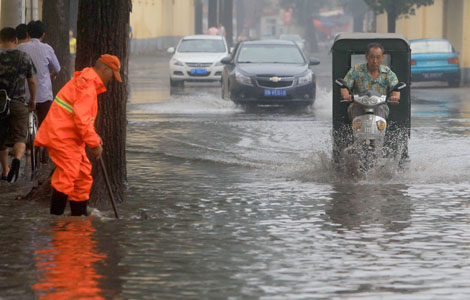
 Beijing rainstorm cancels flights, kills airport worker
Beijing rainstorm cancels flights, kills airport worker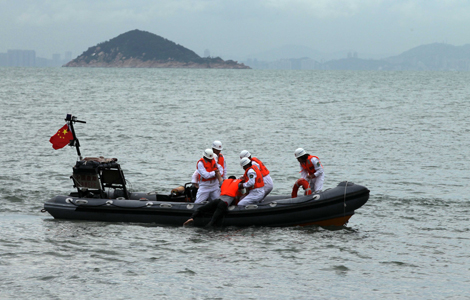
 Highs and lows of marine rescue
Highs and lows of marine rescue
 Lin Dan wins Olympic final rematch over injured Lee
Lin Dan wins Olympic final rematch over injured Lee
 Northeast China braces for major floods
Northeast China braces for major floods
 High-heeled, well heeled
High-heeled, well heeled
Most Viewed
Editor's Picks
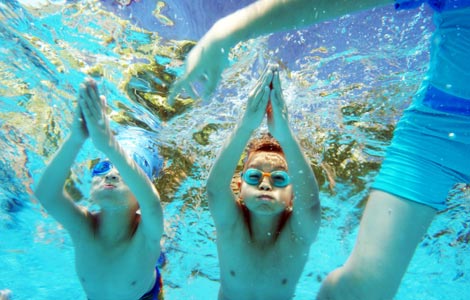
|

|
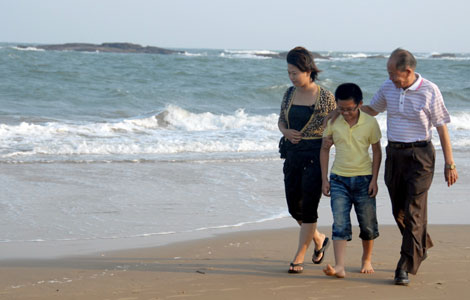
|

|

|
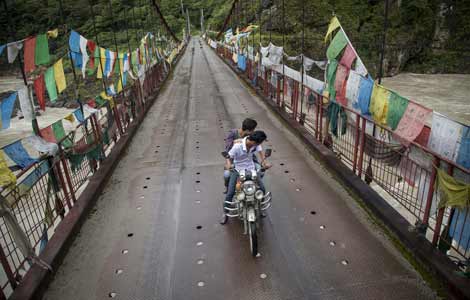
|
Today's Top News
6,007 probed for duty dereliction
Fonterra gets further hit as it recalls milk powder
Chinese take a shine to fine china from UK
New green policy gives industries a big boost
Snowden's father to leave for Russia
Northeast China braces for major floods
Launches highlight India's ambitions
Chinese put on alert in Afghanistan
US Weekly

|

|
